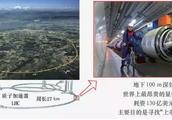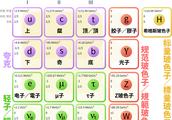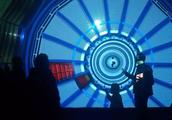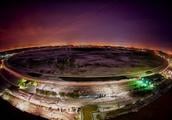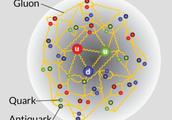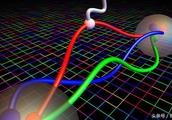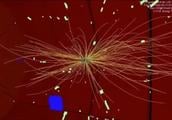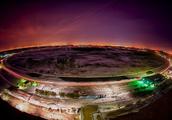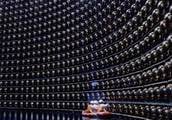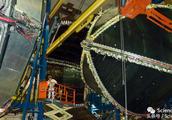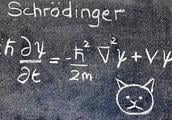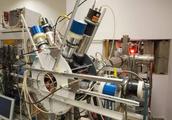When the results of physics experiments turn into beautiful stained glass
At first glance, the stained-glass windows made by particle physicist Hubert van Hecke look like those common but unique works of art that often appear in old western churches or some modern art galleries. But van Hecke's work isn't just about pretty shapes and colors; in fact, they contain elements that physicists love. If you happen to be a particle physicist, look closely and you'll see that these glass windows are actually created by deductions from graphics drawn from particle physics experiments.
 ...
...
△ Particle physicist Hubert van Hecke.
Van Hecke studied at Louisiana State University, where he learned how to make stained glass. Van Hecke said that his father was a painter, so although the undergraduate course is physics, it is also considered to have a certain artistic cell. While working towards a bachelor's degree in physics, I also learned to make stained glass.
Over the course of two semesters, van Hecke learned how to cut pieces of glass from larger sheets, splice them, and weld them together. He recalled: “This course will take you through a variety of different assignments and give you a lot of room to develop your talents. I remember one of them was doing designs related to Fibonacci numbers, and the other was that you had to choose a favorite philosopher, and then make a glass window related to that philosopher’s mind.”
Van Hecke is still creating these windows and mirrors as a graduate student, but has stopped this fun activity since starting full-time research at Los Alamos National Laboratory to focus on heavy ion physics Learn and earn money to support your family. Recently, however, he has returned to his art studio once again, this time creating works inspired by physics.
Van Hecke said: “I wanted to do some designs for a long time, and the graphics of these physics experiments just happened to touch me. Since I found some graphics of experimental results very interesting and beautiful, I began to collect them.”
The first experimental graphic-based glazing he made was a rectangular glazing with red, orange, and yellow:
 ...
...
△ 根據MiniBoone實驗中的中微子研究結果所製造的彩繪玻璃窗。(圖片來源:Hubert van Hecke)
其靈感來自於費米國家加速器實驗室MiniBooNE實驗的中微子味振盪的實驗結果。而其實原圖看上去是這樣的:
 ...
...
(圖片來源:Bertram Schwarzschild)
在那之後他繼續創造了兩件作品,其中一件是基於Tevatron粒子加速器在尋找希格斯玻色子時的實驗結果,另一件作品的靈感來源則來自於夸克和膠子的實驗。
尋找希格斯玻色子是Tevatron在2001年到2011年十年間的主要工作目標,它當時是世界上能量最高的加速器。在這一時期的末期,兩個名為DØ和CDF的實驗,將數據合併在一起進行聯合分析得到了這個結果:
 ...
...
△ 希格斯粒子實驗CDF與DØ'數據合併結果:黑色實線為實驗結果,綠色與黃色色帶為希格斯粒子不存在的預期結果。(圖片來源:The TEVNPH Working Group)
上圖顯示了希格斯粒子具有一定質量的概率,橫軸顯示的是希格斯粒子質量範圍:從100至200 GeV/c²。曲折的黑色粗線為實驗結果,綠色和黃色色帶所顯示的區域為希格斯粒子不存在的實驗預期。因此,從這個實驗結果中,我們可以看到它暗示了在 125 GeV/c²周圍區域似乎有希格斯粒子存在的跡象。但這些結果還不足以聲稱希格斯粒子被找到。
 ...
...
△ 「尋找希格斯粒子」彩繪玻璃窗。(圖片來源:Hubert van Hecke)
2011年,Tevatron被關閉,搜尋希格斯粒子的重任就落在了大型強子對撞機(LHC)身上。2012年,LHC團隊宣布發 現希格斯玻色子(彩繪窗中的紅色小球位置),質量為126 GeV/c²。2013年,彼得·希格斯(Peter Higgs)和弗朗索瓦·恩格爾特(Francois Englert)被授予諾貝爾物理學獎,以表彰他們在50年前就預言了這種粒子的存在。
Van Hecke的另一幅作品是基於 Tevatron 的夸克和膠子實驗。
 ...
...
△ 「夸克和膠子」彩繪玻璃窗。(圖片來源:Hubert van Hecke)
我們較為熟悉的質子和中子都是由夸克構成的,而質子和中子則形成了原子核。夸克與膠子束縛在一起。一個質子由兩個「上」夸克和一個「下」夸克組成。但是, 在量子世界中,所有的粒子都可以短暫的出現,包括其他的夸克(奇、粲、底、頂)和它們的反夸克等。這些短暫存在的粒子在質子內形成一片背景粒子「海」。它 們每一個都攜帶一部分的質子總動量。上面這張彩繪玻璃從左到右分別為膠子、上夸克、下夸克,和奇夸克,顯示了是粒子攜帶了質子的一部分動量的概率,橫軸的 左邊為幾乎零概率(0.001),右邊為1。
 ...
...
△ 夸克和膠子實驗結果。(圖片來源:A.Bazilevsky)
Van Hecke 說:對他來說靈感純粹源自於它們的形狀。不過 van Hecke 創造的作品目前都是基於重離子物理學、基本粒子物理學和中微子等,並沒有將這一愛好延伸到其他學科,或許在天文學和生物學領域也能夠創造出更多的精美作品。
在 van Hecke 的個人主頁上,還放有許多其他彩繪玻璃作品。比如以下這些:
 ...
...
 ...
...
 ...
...
 ...
...
(圖片來源:Hubert van Hecke)
Van Hecke的這些作品還沒有公開展示,但如果未來有機會,他要將這些圖的背後所描述的物理現象都包含進去,如中微子、標準模型等等,可以作為科學傳播的一 種獨特方式。但在此之前,他需要先創造出更多的彩色玻璃窗。在兩個月前,他已進入半退休狀態,只是常常還會去費米實驗室,幫助其他研究人員使用阿貢國家實 驗室的SeaQuest實驗來搜尋暗光子。他希望以後能創造出更多和標準模型、無中微子雙β衰變以及暗物質的相互作用相關的彩色玻璃。
 ...
...
 ...
...
 ...
...
 ...
...
 ...
...

